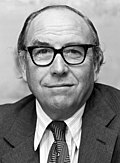| 6th G7 summit | |
|---|---|
 San Giorgio Maggiore in Venice | |
| Host country | Italy |
| Dates | 22–23 June 1980 |
| Follows | 5th G7 summit |
| Precedes | 7th G7 summit |
The 6th G7 Summit was held at Venice, Italy between 22 and 23 June 1980. The venue for the summit meetings was the island of San Giorgio Maggiore in the Venetian lagoon. [1]
Contents
- Leaders at the summit
- Participants
- Issues
- Gallery of participating leaders
- Core G7 participants
- See also
- Notes
- References
- External links
The Group of Seven (G7) was an unofficial forum which brought together the heads of the richest industrialized countries: France, West Germany, Italy, Japan, the United Kingdom, the United States, Canada (since 1976), [2] and the president of the European Commission (starting officially in 1981). [3] The summits were not meant to be linked formally with wider international institutions; and in fact, a mild rebellion against the stiff formality of other international meetings was a part of the genesis of cooperation between France's president Valéry Giscard d'Estaing and West Germany's chancellor Helmut Schmidt as they conceived the first Group of Six (G6) summit in 1975. [4]









